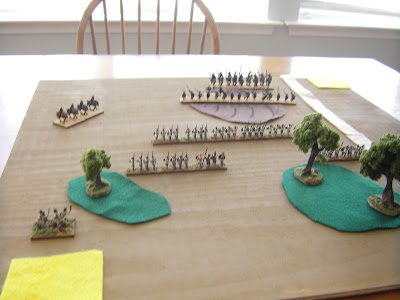 Today, we tried out DBA 3.0, pitting the early Spartans (1/52b) against Galatians (II/30b). Ryan played the Spartans, choosing 12 Spear elements.
Today, we tried out DBA 3.0, pitting the early Spartans (1/52b) against Galatians (II/30b). Ryan played the Spartans, choosing 12 Spear elements. Once again, the dice roll placed me in the position of the defender with the Galatians. I chose a road, two small woods, and one gentle hill as the terrain pieces. Based on our last game, I went with smaller terrain pieces in case the dice required placement of multiple pieces in the same quadrant. I also benefited from a comment, learning that a roll of six results in the attacker choosing only the quadrant for placement, not in the attacker placing the terrain. I had missed the distinction in the rules.

For the Galatians, I fielded 1x General in Chariot (LCh), 2 x Cavalry, 8 x Warband, and 1 Psiloi. I initially tried to field the mounted forces on the right flank, in front of a small wood. However, the measuring stick proved that this wouldn't be possible, it placed my forces to close to the center of the board. So, I settled for placing the force in reserve. My Warbands and Psiloi formed a large group, deployed in the center of the board.
Ryan deployed his Spartans in three groups, with one dispatched to his left flank in column, near a forest.
The dice didn't favor me again today. I rolled very few PIPs in the first turns, resulting in my Psiloi being isolated. Trying a new tactic, I moved them twice in the first turn, finishing the move in the wood between two Spartan groups. I intended to advance the Warband group forward in order to engage the Spartan force on my left. I also started moving my mounted group to the right flank.
Before my plan developed, Ryan advanced and flanked the Psiloi. After a few successful melee rounds, with the terrain advantage saving its skin, the Psiloi was destroyed.
When playing DBA 2.2, I had used a rule and tape measure, since movement distances were in inches. I created a measuring stick, seen on the table, for DBA 3.0.
As the battle progressed, we ended up with two engagements. One fight occurred between a Spartan group, four Galatian warbands and the Galatian mounted forces. The other fight involved six Spartan spear elements in two groups and four Warbands. After six rounds of melee between these groups, with numerous recoils and pursuits, Ryan won the game 4 -3.
Intrepretations
We had to carefully review the rules on several points.
Pursuit - We were unsure if supporting Warband elements pursue along with the unit in combat. I interpreted the following statement on page 12 as meaning "yes."
"An element of any of ........Warbands (or that could provide rear support to any element of these even if not providing such support against current opponents) that is fighting foot,..."
Effect of destroyed unit on rear support- If a Warband element that is being supported is destroyed, what happens to the Warband element providing rear support? If both elements have been flanked when the element in combat is destroyed, is the rear support unit also destroyed?
Since the paragraph on destroyed elements doesn't address the effect on a rear support unit, we didn't destroy rear support units.
A Puzzler
During the last turn, Ryan flanked a Warband element that had rear support. While another Spartan element is engaged with a neighboring unit, the Warband element had no enemy to its front. I rotated both the flanked element and its rear support element to face the Spartan. I remain unsure if we maneuvered the forces correctly. The game ended before this melee occurred. Thoughts?
I have made numerous notes on the 3.0 rules. We are playing one more game - Kappadokians versus Galatians - before I submit my comments to the Yahoo DBA Group.
I'm busy painting elements for a Hellenistic Army Morph plan using the 3.0 draft Army lists. When those units are ready, we will take another run at the rules with some Pikes in the action.








